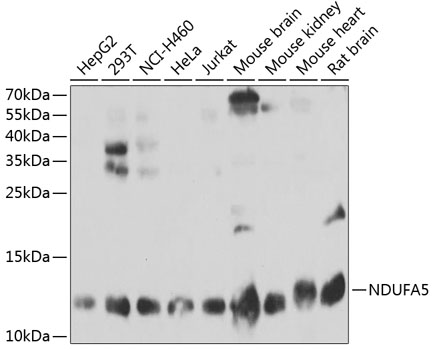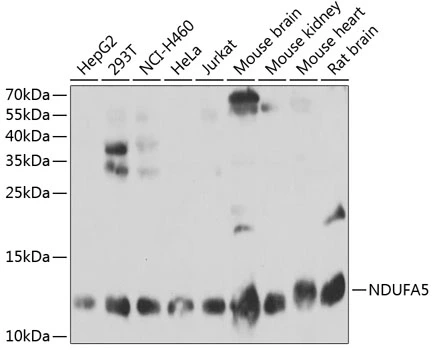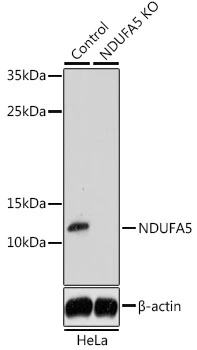NDUFA5 antibody [N1C3]
GTX111016
ApplicationsWestern Blot, ImmunoHistoChemistry, ImmunoHistoChemistry Paraffin
Product group Antibodies
TargetNDUFA5
Overview
- SupplierGeneTex
- Product NameNDUFA5 antibody [N1C3]
- Delivery Days Customer9
- Application Supplier NoteWB: 1:500-1:3000. IHC-P: 1:100-1:1000. *Optimal dilutions/concentrations should be determined by the researcher.Not tested in other applications.
- ApplicationsWestern Blot, ImmunoHistoChemistry, ImmunoHistoChemistry Paraffin
- CertificationResearch Use Only
- ClonalityPolyclonal
- Concentration1.47 mg/ml
- ConjugateUnconjugated
- Gene ID4698
- Target nameNDUFA5
- Target descriptionNADH:ubiquinone oxidoreductase subunit A5
- Target synonymsB13, CI-13KD-B, CI-13kB, NUFM, UQOR13, NADH dehydrogenase [ubiquinone] 1 alpha subcomplex subunit 5, NADH dehydrogenase (ubiquinone) 1 alpha subcomplex, 5, 13kDa, NADH-ubiquinone oxidoreductase 13 kDa-B subunit, complex I 13kDa subunit B, complex I subunit B13, type I dehydrogenase, ubiquinone reductase
- HostRabbit
- IsotypeIgG
- Protein IDQ16718
- Protein NameNADH dehydrogenase [ubiquinone] 1 alpha subcomplex subunit 5
- Scientific DescriptionThe human NDUFA5 gene codes for the B13 subunit of complex I of the respiratory chain, which transfers electrons from NADH to ubiquinone. The high degree of conservation of NDUFA5 extending to plants and fungi indicates its functional significance in the enzyme complex. The protein localizes to the inner mitochondrial membrane as part of the 7 component-containing, water soluble iron-sulfur protein (IP) fraction of complex I, although its specific role is unknown. It is assumed to undergo post-translational removal of the initiator methionine and N-acetylation of the next amino acid. The predicted secondary structure is primarily alpha helix, but the carboxy-terminal half of the protein has high potential to adopt a coiled-coil form. The amino-terminal part contains a putative beta sheet rich in hydrophobic amino acids that may serve as mitochondrial import signal. Related pseudogenes have also been identified on four other chromosomes. [provided by RefSeq]
- Storage Instruction-20°C or -80°C,2°C to 8°C
- UNSPSC12352203
References
- Lee H, Lee TJ, Galloway CA, et al. The mitochondrial fusion protein OPA1 is dispensable in the liver and its absence induces mitohormesis to protect liver from drug-induced injury. Nat Commun. 2023,14(1):6721. doi: 10.1038/s41467-023-42564-0Read this paper
- Lee H, Smith SB, Sheu SS, et al. The short variant of optic atrophy 1 (OPA1) improves cell survival under oxidative stress. J Biol Chem. 2020,295(19):6543-6560. doi: 10.1074/jbc.RA119.010983Read this paper
- Lee H, Smith SB, Yoon Y. The short variant of the mitochondrial dynamin OPA1 maintains mitochondrial energetics and cristae structure. J Biol Chem. 2017,292(17):7115-7130. doi: 10.1074/jbc.M116.762567Read this paper








